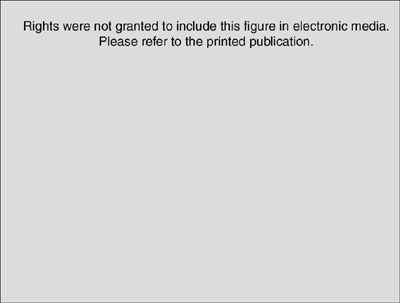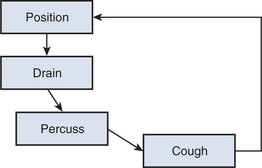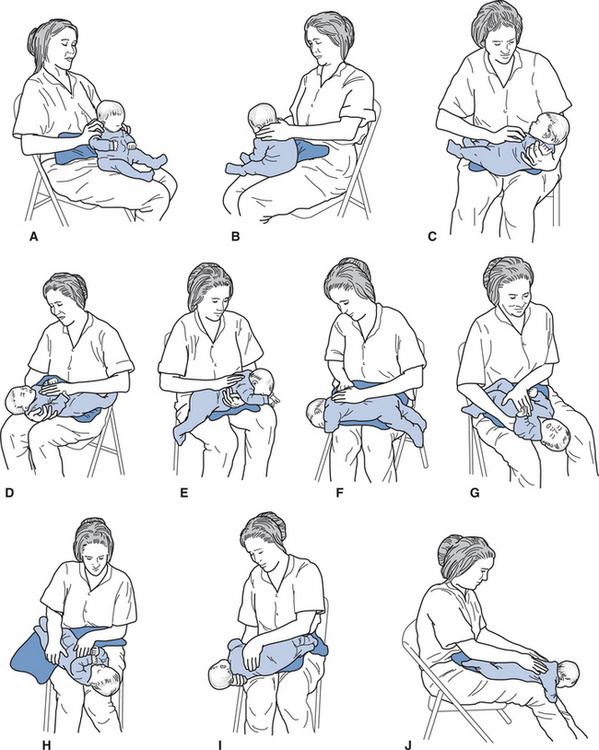Chapter 10 Massage for the Patient with a Respiratory Condition
Massage techniques for patients suffering from respiratory disorders center around two basic concepts: (1) helping patients gain control of their breathing pattern by assisting them to relax, and (2) helping patients to loosen and clear mucus from their lungs. Although these are important issues for the patient, they are a relatively small part of the overall rehabilitation process for the management of pulmonary disorders. A wide variety of treatment techniques, including massage, have been used for this purpose over many decades in most parts of the world. This treatment is generally referred to as chest physical therapy (Frownfelter & Dean, 2006; Hillegass & Sadowsky, 1994; Irwin & Techlin, 2005; Watchie, 1995; Webber & Pryor, 1993).
Many patients who suffer from chronic respiratory dis-tress could be significantly helped by some simple and cost-effective procedures. These techniques might be tried before more expensive equipment and medications are ordered, and, of course, much of the physical therapy involves teaching patients a variety of strategies to help themselves through distress plus techniques to prevent further episodes. These valuable and cost-effective treatments are lost if the patient receives only a machine and medication. Thus the typical goals of a chest physical therapy program are listed in Box 10-1.
Health statistics show a consistent increase in the incidence of chronic obstructive pulmonary disease (COPD). From 1950 to 1960, for example, deaths attributable to emphysema and chronic bronchitis increased more than fourfold (Carey, 1967). In an additional study (1950–1965), the mortality rate was shown to double every 5 years. Deaths increased almost eightfold, from 3157 patients in 1950 to 23,700 patients in 1965 (Weiss et al., 1969). By the late 1970s, data suggest that about 27% of adult males and 13% of females have symptoms of spirometric abnormalities indicative of COPD (Petty, 1978). To make matters worse, there has been a resurgence of serious diseases such as tuberculosis and the emergence of new and dangerous strains of flu viruses. It is clear from the statistics that the quality and duration of many lives are significantly affected by this disease. In effect, COPD is rapidly becoming one of the most important health problems of our time. It behooves health professions to upgrade their understanding and capacity to provide effective treatment. As with just about every facet of modern health care, a coordinated and consultative approach involving a variety of expert practitioners is likely to provide the best care for the patient.
Several important treatment concepts are involved in chest physical therapy, the most important of these being postural drainage, percussion, vibration and shaking, facilitation techniques, breathing exercise and retraining, relaxation techniques, posture correction and retraining, graded exercise, and endurance programs. In addition, patient and caregiver education are critical for patient compliance and long-term success. A detailed discussion of all these areas is well beyond the scope of this chapter. Instead, the intention here is to define and describe the contributions of massage techniques to the treatment of patients with a respiratory disorder; the part played by methods such as percussion and vibration is presented in detail, and other techniques are mentioned only briefly. The references cited earlier, together with other materials, provide excellent discussions of the specialty area of cardiopulmonary physical therapy, including details of treatment techniques (Frownfelter, 1987; Frownfelter & Dean, 2006; Hillegass & Sadowsky, 1994; Irwin & Techlin, 2005; Mackenzie, Imle, & Ciesla, 1989; Watchie, 1995; Webber & Pryor, 1993).
RELAXATION
Relaxation is often an important issue for patients suffering from respiratory disease, especially one that is characterized by constricted airways or marked shortness of breath. Anxiety, fear, and outright panic are symptoms commonly associated with an inability to breathe. Not surprisingly then, people, especially children who suffer from chronic respiratory diseases such as asthma, find it difficult to relax and thus develop many postural problems related to their overactive muscles. Helping the patient to learn how to relax, breathe properly, and clear the airway of mucus is therefore an important goal of treatment. Because massage is especially effective in promoting relaxation and lowering anxiety and other techniques are effective in clearing the airway, it is not surprising that massage can be an effective treatment, especially for children with asthma (Fiels, 1998).
Various techniques are available to teach the patient how to relax. Two common strategies—the contrast and the induction methods—were discussed in some detail in Chapter 3 and will not be repeated here. Either of these methods are suitable; even a combination of the two approaches would also work well for some patients. An important modification, however, for both techniques relates to the position of the patient. Supine lying is a position in which most, if not all, patients with a respiratory disease will have difficulty breathing. A suitable alternative would be sitting upright in the bed or a comfortable armchair. Appropriate pillows should support the knees, lumbar spine neck, and perhaps the elbows and forearms. As patients learn to relax, they are better able to control their breathing. Being able to control breathing gives patients an important method to reduce their anxiety level and avoid panic. It also makes it possible for them to pay attention to their posture and to correct and prevent problems.
AIRWAY CLEARANCE
The removal of mucus (sputum) from the airways and lungs is a major goal of treatment for any patient who has a pulmonary disorder characterized by significant mucus production. Clearing the airway paths is therefore a vital part of cardiopulmonary rehabilitation for both children and adults, and a variety of techniques have been developed to make this possible (Ciesla, 1996; Hugh, 1999; Jones & Rowe, 2000; Oberwaldner & Zach, 2000; Rivington-Law et al., 1984; Spotnitz, 1978; Williams et al., 2000; Zhu, 1998). Airway clearance requires the removal of adherent (and possibly infected) mucus with the application of three basic techniques:
These three procedures are integrated into a total treatment process, in which there is an orderly progression from one part to another. Assuming the patient has been thoroughly screened and there are no contraindications to the procedure, treatment begins with the patient properly supported in the appropriate postural drainage position. The patient is allowed to rest in this position while the lung segments drain. Following a period of approximately 10 to 15 minutes, percussion and vibration techniques are administered to the appropriate parts of the patient’s chest. Deep breathing and a cough then follow, several times if necessary. The patient is then allowed to rest in the drainage position, and the cycle is repeated until the chest is clear, unless the patient is fatigued, in which case treatment is discontinued. The basic concept is depicted in Figure 10-1.
POSTURAL DRAINAGE
Postural drainage consists simply of allowing gravity to promote movement (drainage) of lung secretions toward the bronchial tree and the trachea, where the patient can expel them by coughing. Gravity both helps and hinders the normal movement of lung secretions. Essentially, gravity tends to drain the upper lobes and pool secretions in the lower lobes. The consistent movement of the cilia, which line the respiratory passages, together with the normal cough reflex usually ensure proper airway clearance of the respiratory passages. Under normal circumstances, the system is extremely efficient at keeping the airway clear; however, disease or the effects of surgery may render the patient unable to expel retained mucus from the lungs. Mucus retained in the lungs is a major focus for infection. The warm, dark, and damp environment deep within the lungs is the perfect incubation chamber for bacteria and viruses. If a serious infection occurs, it is costly to treat and can have serious, possibly fatal, consequences.
All measurements are made from the floor to the tip of the leg of the table or bed. The high tip is used mainly to drain various parts of the lower lobes. It is the combination of positioning and tipping the patient that makes postural drainage so effective. Because a detailed description of all of the postural drainage techniques is beyond the scope of this chapter, Figure 10-2 has been included to provide an easy-to-follow summary of the various positions. The reader is referred to other texts on the subject, including Frownfelter and Dean (2006) and Hillegass and Sadowsky (1994).

Figure 10-2 Basic Postural Drainage Positions
(From White GC: Basic clinical competencies for respiratory care: an integrated approach, Albany, NY, 1988, Delmar.)
Certain diseases, such as cystic fibrosis, cause the production of large amounts of respiratory secretions. It is extremely important, especially in small children, that these secretions be removed daily; otherwise, the patient is likely to develop a serious, perhaps fatal, chest infection. Figure 10-3 illustrates a variety of postural drainage positions suitable for the treatment of small children. The positions illustrated in Figure 10-2 are not suitable for small children for many reasons, not the least of which is that the child will probably not keep still long enough for the drainage to be effective. As the child grows older, adult positioning techniques can be used. Watchie’s book (1995) is another excellent source of information in this area.










